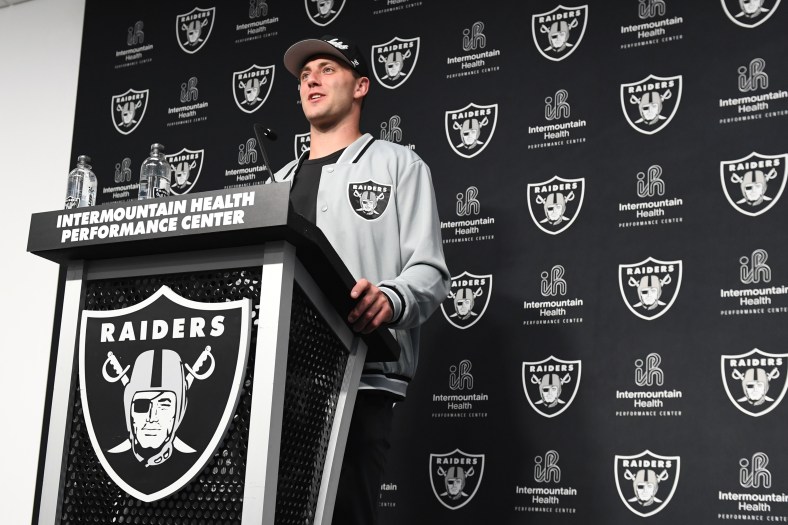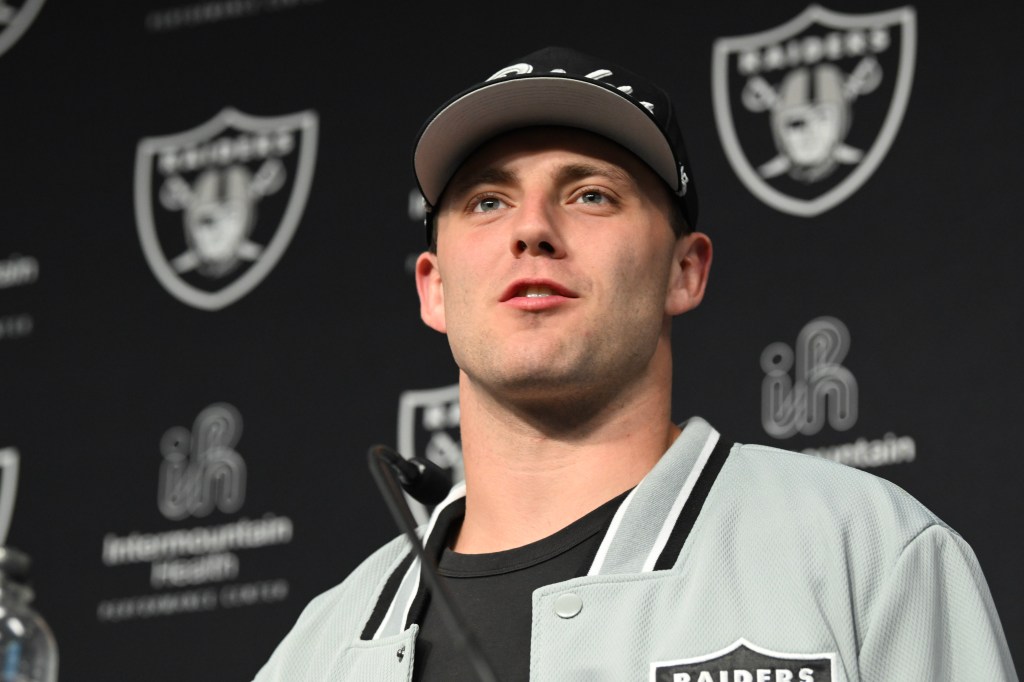
By now, you have read through post-draft grades and early individual grades for each draft pick. So, let’s examine how Las Vegas Raiders general manager Tom Telesco put together his 2024 class.
After a deep dive into Telesco’s draft history in the weeks leading up to the 2024 NFL Draft, he stuck to some tendencies and also gave us an idea of what he thinks of the Raiders’ roster.
Which roster needs did Telesco prioritize, and what type of player is he looking for in certain rounds and at specific positions?
With the 2024 NFL Draft in the books, let’s review some of the major takeaways from Telesco’s first Raiders class.
Related: Raiders Game-Changer: Is Brock Bowers the next Hall of Fame tight end?
Tom Telesco’s 1st-round picks will be unpredictable

You cannot predict Tom Telesco’s first-round draft pick with much certainty unless the Raiders have the No. 1 overall selection and a need at quarterback in a class with a presumptive top prospect.
Telesco may not know whom he will pick in the first round until draft day with the best-player-available approach.
Telesco shocked people who expected him to take an offensive lineman or a cornerback with pick No. 13 last Thursday.
Perhaps, we all should’ve considered a surprise with tight end Brock Bowers falling out of the top 10.
As the Los Angeles Chargers general manager last year, Telesco took wide receiver Quentin Johnston in the first round even though wideouts Keenan Allen and Mike Williams had multiple years left on their respective contracts.
Yes, Allen and Williams have dealt with injuries in the recent past. But the Chargers had bigger roster needs than wide receiver going into the 2023 draft.
In true best-player-available fashion, Telesco selected Bowers with second-year tight end Michael Mayer on the roster.
While Telesco’s selection shocked many, he didn’t make a bad pick. This isn’t comparable to the Raiders using the No. 4 overall selection in 2019 on Clelin Ferrell, who may have been a late first-rounder.
The Raiders didn’t reach for Bowers; they took a prospect widely regarded as one of the best players in the class with Pro Bowl or All-Pro potential.
Anyone who views Bowers as just a tight end is shortchanging what he can do on the field as a mismatch playmaker who can line up in multiple spots across an offensive formation.
If the Raiders tap into Bowers’ versatility, he could be one league’s best “positionless” players.
Antonio Pierce’s influence on Las Vegas Raiders draft plans is evident

Even though Tom Telesco made the selections, head coach Antonio Pierce had an influence on this draft class.
After owner Mark Davis fired Josh McDaniels and promoted Pierce to head coach midway through the 2023 campaign, the team took on a different demeanor.
Pierce’s Raiders embraced a confident roughhouse mentality, but the team also played with a high football IQ. When you combine those qualities with the athleticism on the roster, guys will make plays in crucial moments.
Tight end Brock Bowers, interior offensive lineman Jackson Powers-Johnson and linebacker Tommy Eichenberg are the physical, high-football-IQ prospects. Safety Trey Taylor fits in this group to an extent; he’s a physical safety who’s comfortable going downhill to support the run defense.
Telesco targeted prospects with above-average physical tools in the third and fourth rounds.
Offensive lineman D.J. Glaze has a jaw-dropping 85¼-inch wingspan. At 6-foot-2 and 188 pounds, Decamerion Richardson clocked a 4.34 40-yard time at the NFL Scouting Combine.
The Raiders selected running back Dylan Laube and cornerback M.J. Devonshire in the sixth and seventh rounds, but they had highly-productive collegiate careers.
As a pass-catcher alone, Laube caught 117 passes for 1,163 yards and nine touchdowns over the last two years. Devonshire recorded 18 pass breakups and seven interceptions.
Laube has the high football IQ to pick up third-down pass protection assignments and become a reliable pass-catcher who can run receiver routes out of the backfield.
Devonshire ran a 4.45 at the combine and plays with great instincts, which is how he’s able to find the football in pass coverage.
Pierce’s Raiders are physical and athletic, but they’re not reckless, which is a much-needed transition from players on the heavily penalized teams in previous years.
Related: Analyzing the Las Vegas Raiders brilliant 2024 NFL Draft strategy
Las Vegas Raiders wanted a quarterback, but they were not desperate for one
Before you gripe about a Band-Aid at the quarterback position, the Raiders made the logical move to sign Gardner Minshew before the draft in case they didn’t have a shot at taking a top quarterback prospect, which is exactly what happened last Thursday.
Six quarterbacks heard their names called before the Raiders went on the clock with the No. 13 pick.
According to ESPN’s Adam Schefter, the Raiders would’ve considered quarterback Michael Penix Jr. if he slipped past the Atlanta Falcons.
Despite missing out on top quarterback prospects, Telesco didn’t draft a passer on Days 2 or 3. Instead, he signed Carter Bradley (the son of former Raiders defensive coordinator Gus Bradley) as an undrafted free agent.
In the fifth round, the New Orleans Saints and New York Jets selected Spencer Rattler and Jordan Travis, respectively.
In the sixth round, the New England Patriots and Baltimore Ravens took Joe Milton III and Devin Leary, respectively.
In the seventh round, the Green Bay Packers selected Michael Pratt.
The Raiders didn’t feel the need to take any one of those quarterbacks, which tells you they had their eyes on a player who could challenge Minshew and Aidan O’Connell for the starting job not another development prospect at the position.
Thayer Munford Jr. made a strong impression on the coaching staff

The Raiders didn’t draft an offensive tackle until they picked D.J. Glaze in the third round, which bodes well for Thayer Munford Jr.
Last season, Munford played the swing tackle role, lining up at right and left tackle. According to Pro Football Focus, he allowed four sacks and committed just one penalty while on the field for 521 snaps.
At Maryland, Glaze played tackle on both sides of the offensive line. He could compete directly against Munford for the right tackle spot.
Or, as Bleacher Report scout Brandon Thorn suggested, Glaze could move inside to guard because of his lack of lateral foot quickness, which shows up against speedy edge-rushers.
“Overall, Glaze combines polished technique with good play strength and a patient, calculated approach to win the leverage battle more often than not despite below-average athletic ability,” Thorn wrote in his scouting report.
“Along with his tackle experience, Glaze should be able to carve out a role on an NFL roster at guard while offering the ability to play tackle in a pinch.”
Munford seems like the front-runner to start at right tackle as the coaching staff figures out where Glaze is best suited to play along the offensive line.
Related: Biggest losers from the 2024 NFL Draft
Las Vegas Raiders are not hyper focused on running back speed
Zamir White clocked 4.4-second speed at his combine workout, though he’s more of a downhill ball-carrier than someone who puts moves on a defender and breaks away with top gear speed.
Alexander Mattison isn’t known for elite speed either. At his combine workout, he recorded a 4.67-second 40-yard time.
With White and Mattison atop the Raiders’ running back depth chart, you may have expected Telesco to add a true burner to the backfield rotation.
Instead, Las Vegas selected Dylan Laube, who ran a 4.54-second 40-yard time.
Laube isn’t slow, though. He’s a rock-solid 5-10, 208 pounds, which is similar to the size of Telesco’s previous running back draft picks. Take a look at the height and weight consistency of Telesco’s drafted tailbacks.
2022: Isaiah Spiller (6-0, 217 lbs)
2021: Larry Rountree III (5-11, 211 lbs)
2020: Joshua Kelley (5-11, 212 lbs)
2018: Justin Jackson (6-0, 199 lbs),
2015: Melvin Gordon (6-1, 215 lbs)
2014: Marion Grice (6-0, 208 lbs)
In order for a running back to catch Telesco’s eye, he must be on the thicker side in build.
So, you can toss out the smallish change-of-pace tailback who’s 5-8 and weighs closer to 190 than 200 pounds. That prospect doesn’t have enough meat on his bones for Telesco.
Laube fits the description, and he’s a capable pass-catcher with wide-receiver hands, which is what the Raiders need in obvious third-down passing situations.
Don’t sleep on Laube’s 4.54 speed. After breaking a tackle, he can accelerate and escape defenders in open space.
Maurice Moton covers the Las Vegas Raiders for Sportsnaut. You can follow him on Twitter at @MoeMoton.